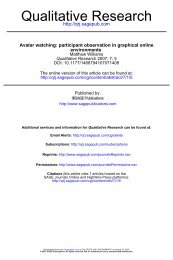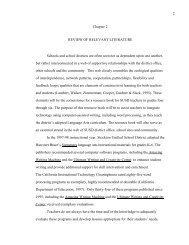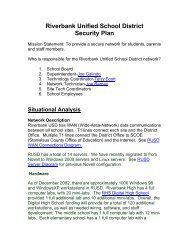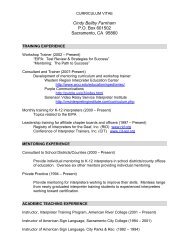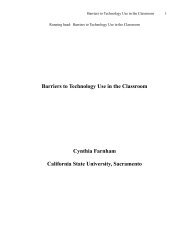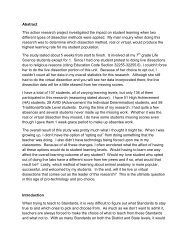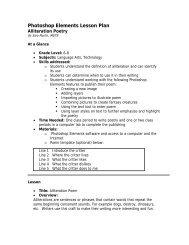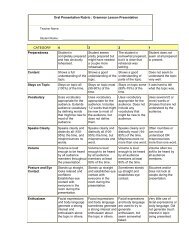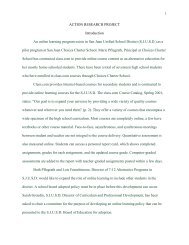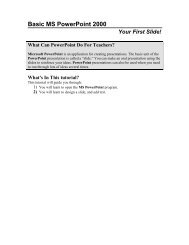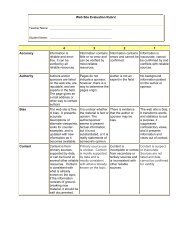Action Research Project: Searching – From the Inside Out - iMET
Action Research Project: Searching – From the Inside Out - iMET
Action Research Project: Searching – From the Inside Out - iMET
Create successful ePaper yourself
Turn your PDF publications into a flip-book with our unique Google optimized e-Paper software.
<strong>Action</strong> <strong>Research</strong> <strong>Project</strong>: <strong>Searching</strong> <strong>–</strong> <strong>From</strong> <strong>the</strong><strong>Inside</strong> <strong>Out</strong>Cathie Conforti, Gail Desler, Alix PeshetteStatement of Problem“Instead of drowning in <strong>the</strong> abundance of information that floods<strong>the</strong>ir lives, information literate people know how to find, evaluate,and use information effectively to solve a particular problem ormake a decision.”Dr. Francis KeppelBeing able to find answers to problems or questions is a skill all people find useful.Whe<strong>the</strong>r <strong>the</strong> need arises to find which schools have <strong>the</strong> highest API scores or simply tofind <strong>the</strong> closest <strong>the</strong>ater where “Traffic” is playing, everyone needs to find answers.Indeed, in <strong>the</strong> age of information, those who are able to retrieve information quickly andefficiently are considered “information literate.”Today students face a new challenge in achieving information literacy. Being literaterequires more than just being able to open a textbook, scan <strong>the</strong> index, and locate <strong>the</strong>answer. Given <strong>the</strong> vast amount of information now available to students (regardless ofgrade-level), textbooks are simply one type of source students can turn to in <strong>the</strong>ir questfor information. Savvy textbook publishers now include Internet sites in <strong>the</strong>ir chapters,knowing that <strong>the</strong> Internet offerings are not limited to state and district adoption cycles.Many districts have budgeted more for Internet wiring than for textbooks. Students areoften logging on to <strong>the</strong> Internet before checking out anything from <strong>the</strong> library.However, not all students are actually finding useful information as <strong>the</strong>y venture out intocyberspace. In fact, many of our students are overwhelmed by <strong>the</strong> amount of informationavailable, <strong>the</strong> juxtaposition of contradictory information, and a format that does notinstantly provide <strong>the</strong> “right answer,” something <strong>the</strong>y could always count on from <strong>the</strong>irtextbook. “Information helps us reach conclusions, make our choices, and communicatemore effectively. But <strong>the</strong> good stuff is often buried in heaps of junk” (Valenza, 2000).Without <strong>the</strong> tools for wading through <strong>the</strong> Internet’s information glut, our students are nottruly information literate.To address <strong>the</strong> problem of information literacy, we see a need to provide our studentswith an information toolkit. This kit will include strategies not only for conductingInternet searches, but also for evaluating <strong>the</strong> usefulness of <strong>the</strong> information. Informationliterate students who can find and evaluate information will welcome <strong>the</strong> challenge to gobeyond <strong>the</strong> distilled information of <strong>the</strong> textbook <strong>–</strong> and beyond state and district mandatedstandards.
Area of FocusThe purpose of this project is to create a set of lessons to assist our students in developingstrategies for locating and evaluating online information. The lessons are designed fordirect instruction and can be taught in less than two weeks of class time. Our “toolkit”will include a pre- and post-survey for assessing student ability to retrieve information; awebsite evaluation template to help students question <strong>the</strong> reliability of information; anote-taking template to train students to document <strong>the</strong>ir own progress in locating usefulinformation; and a reflection piece to encourage students to think about <strong>the</strong> steps <strong>the</strong>yhave taken into <strong>the</strong> world of research.Rationale StatementWe recognize <strong>the</strong> need in our classrooms to equip our students with tools for locating andevaluating information. As a result of observing our own 5 th , 6 th , and 7 th grade studentsin <strong>the</strong> process of doing Internet research, we are concerned with <strong>the</strong>ir often hit-and-missapproach. It is not uncommon for our students to complete a research session, forinstance, with printouts of questionable value on <strong>the</strong> status of women during <strong>the</strong> HanDynasty or claims of “I couldn’t find anything.” Yet we have no intention of limiting ourstudents to textbook-driven research topics. We recognize that “successful searching andefficient electronic investigations must rest upon a carefully developed, structuredfoundation of information literacy skills that would include solid questioning,prospecting, translating and inventive abilities (McKenzie, 1999).”If we can provide our students with <strong>the</strong> tools for locating and evaluating information,<strong>the</strong>y will have <strong>the</strong> information literacy skills necessary to succeed in an increasinglystandards-driven curriculum and technology driven-work force.Review of Relevant Literature“Increasingly, ‘becoming literate’ will become a more precise term than ‘beingliterate,’ reflecting <strong>the</strong> continual need to update our abilities to communicatewithin new technologies that regularly appear.” (Donald Leu, 1999)Across <strong>the</strong> nation our schools are scrambling to find funding for wiring to <strong>the</strong> Internet.As more and more classrooms go online, teachers are recognizing that <strong>the</strong> definition ofliteracy is changing. <strong>From</strong> <strong>the</strong> 1800’s when people were often considered literate if <strong>the</strong>ycould sign <strong>the</strong>ir signature with <strong>the</strong>ir name ra<strong>the</strong>r than an X, to <strong>the</strong> 1900’s when Webster’sprimary dictionary definition of literate was “able to read and write,” we now have toexamine literacy from a 2000’s perspective. Today <strong>the</strong> word literacy is frequentlycombined with <strong>the</strong> word information. Many educational associations are attempting to
define literacy in <strong>the</strong> information age. The Association of Supervision and CurriculumDevelopment (ASCD), for instance, states that “information literacy …equips individualsto take advantage of <strong>the</strong> opportunities inherent in <strong>the</strong> global information society.Information literacy should be a part of every student’s educational experience(Montgomery, 1999).” Michael Lorenzen, in his article “The Land of Confusion? HighSchool Students and Their Use of <strong>the</strong> World Wide Web for <strong>Research</strong>,” points out that<strong>the</strong>re is some urgency in <strong>the</strong> need for schools to promote information literacy. If we aresimply to turn students loose on <strong>the</strong> web without providing structure and strategies to<strong>the</strong>ir search for and evaluation of information, <strong>the</strong> end product could be a generation ofinformation illiterate students.An Escalating Need for LiteracyAccording to Naisbitt, as quoted in <strong>From</strong> Library Skills and Information Literacy, <strong>the</strong>Information Age will impact our future job market. The demand for white-collar jobsover blue-collar jobs will increase. Information ga<strong>the</strong>ring and information sharing willbecome a basic job skill requirement. Yet our schools still maintain <strong>the</strong> Industrial Ageformat of direct, assembly-line instruction by <strong>the</strong> teacher to rows of students. Newmodels need to be observed and evaluated in order to prepare our students for <strong>the</strong> realworld of work <strong>the</strong>y will encounter as adults. “In this rapidly changing environment, <strong>the</strong>role of educators has changed from disseminators of a finite knowledge base ofinformation to facilitators of <strong>the</strong> process of accessing and interpreting new information.There is no way to predict what core of facts our students will need to know in <strong>the</strong>twenty-first century. Therefore, we need to teach <strong>the</strong>m to be well-informed, creativethinkers and active participants in our society. The number of available facts will changeexponentially in <strong>the</strong>ir lifetimes, but <strong>the</strong> basic skills of information processing will remainconstant (Librarians, 1998).”The purpose of our action research is to examine <strong>the</strong> definition of literacy in <strong>the</strong>information age and to develop sound strategies for teaching our students how to searchfor information on <strong>the</strong> Internet and how to evaluate information. We envision that <strong>the</strong>end product of our research will be a toolkit for teaching Internet search strategies, madeavailable to our individual school districts both online and on CD-ROMs.Defining LiteracyThe concept of literacy in <strong>the</strong> information age is a complex one. In order to understandcurrent definitions of literacy, it is helpful to understand <strong>the</strong> evolution of <strong>the</strong> definition.Although civilizations are often judged by <strong>the</strong>ir literacy rates, literacy needs (anddefinitions) have changed over <strong>the</strong> centuries. To <strong>the</strong> citizens of ancient Mesopotamia,basic literacy was <strong>the</strong> ability to keep simple accounting records of merchandise traded.Scribes purposefully chose not to simplify <strong>the</strong> rules for decoding cuneiform writing.Why should <strong>the</strong> masses have access to literacy? Only <strong>the</strong> wealthy were likely to send<strong>the</strong>ir children to scribe school. The ability to correspond through writing was hardly abasic job requirement. Their societies could function quite well with high “illiteracy”rates.
In medieval Europe, <strong>the</strong> Catholic Church served as <strong>the</strong> bastion of literacy, informationand research. Lesser sons of <strong>the</strong> nobility and clever sons of <strong>the</strong> peasantry could enter <strong>the</strong>priesthood and establish a career based on literacy. Besides <strong>the</strong> obvious religiousimplications of joining <strong>the</strong> Church, men of <strong>the</strong> cloth were also prepared to become <strong>the</strong>custodians of <strong>the</strong> written word and advisors to <strong>the</strong> often-illiterate rulers. A large part of<strong>the</strong> duties of some monastic orders was <strong>the</strong> hand copying of manuscripts. This tediousprocess resulted in small numbers of manuscripts that were jealously guarded by <strong>the</strong>monasteries and revered by <strong>the</strong> commonality as sacred text. Thus, if a thought or opinionwas written, it was considered <strong>the</strong> 'truth.' Clerics who rose to positions of trust andbecame advisors to monarchs often wielded considerable power behind <strong>the</strong> throne. Theremaining 90% of <strong>the</strong> population, <strong>the</strong> peasants, by lack of literacy, were destined for alife that was brutish, exhausting and short. Without literacy, <strong>the</strong> peasants had no powerto change <strong>the</strong>ir circumstances by rising above <strong>the</strong>ir station in life. Thus, literacyrepresented real power.In 1455, Johannes Guttenburg's invention of movable type rapidly made <strong>the</strong> printed wordmore accessible. "Gutenberg's invention brought about changes, and it is interesting tospeculate on <strong>the</strong> major possible parallels between <strong>the</strong> changes that flowed fromGutenberg’s invention and those that can come from fast computing and <strong>the</strong> Internet(King, February 22,1997)." The context of literacy changed from being a religiousvehicle to being a secular vehicle of mass communication. The impact of mass-producedsecular information created a tremendous rise in <strong>the</strong> literacy rates of Western Europe."The effect on communication and <strong>the</strong> spread of ideas was huge. Barriers betweenscholar and citizen, between <strong>the</strong> learned elite and those who needed to learn, were brokendown (King, February 22,1997)."Following <strong>the</strong> American Revolution, leaders such as Jefferson viewed literacy as “centralto <strong>the</strong> survival of government as informed citizens made reasoned decisions at <strong>the</strong> ballotbox (Leu).” By 1959 <strong>the</strong> United Nation’s published its “Declaration on <strong>the</strong> Rights of <strong>the</strong>Child: Principle 7,” declaring that “<strong>the</strong> child is entitled to receive free and compulsoryeducation, at least in <strong>the</strong> elementary stages (Langford, 1998).”Today literacy is considered a universal right. Its definition has changed greatly from <strong>the</strong>ancient river civilizations to modern-day travelers on <strong>the</strong> information highway. Todayliteracy involves more than <strong>the</strong> ability to read and write. Linda Langford, in her article“Information Literacy: A Clarification,” cites studies done by Kuhlthau that tie <strong>the</strong>definition of literacy to <strong>the</strong> current information needs of a society. Kuhlthau found that“to be literate was not only to recognize when information was required, but involved <strong>the</strong>ability to construct one’s own knowledge through a process that gave meaning and selfinterestto <strong>the</strong> notion of learning throughout a lifetime (Langford, 1998).” Part of today’sliteracy challenge is being able to deal with vast and rapidly escalating amounts ofinformation. According to Langford, <strong>the</strong> “mere ability to read and write is beingtranslated into <strong>the</strong> ability to read, write, and to develop <strong>the</strong> capacities to understand,absorb, assimilate, and digest <strong>the</strong> images being transmitted electronically with <strong>the</strong> addedcapacity to communicate <strong>the</strong>se images electrographically (Langford, 1998).”
Donald Leu has also studied <strong>the</strong> ever-changing definition of literacy. He applies <strong>the</strong> term“deictic” to literacy definitions. He explains that “deictic” refers to words whosemeanings change quickly. Words such as “today,” for instance, change meaning literallyovernight. Depending when I say “today,” it could mean at this moment in time, or if Isay “today” tomorrow, it means “tomorrow.” Leu explains that it is not so much <strong>the</strong>passing of time <strong>the</strong> affects <strong>the</strong> meaning of literacy, but ra<strong>the</strong>r rapidly emerging newtechnologies and <strong>the</strong> envisionment of how <strong>the</strong>se improved technologies might be used.Leu explains <strong>the</strong> difficulty of conducting long-term studies on <strong>the</strong> impact of technologyintegration into <strong>the</strong> curriculum on improved student learning (Leu). In our classrooms,for instance, we would no longer consider students to be high-end consumers oftechnology for simply being able to use a word processing program. If we could travelback more than ten years though, we would still find teachers who were concerned about<strong>the</strong>ir students having typing skills as opposed to keyboarding skills. Ten years ago, fewof our students or parents would have emailed us regarding class assignments, nor wouldmany teachers have referred those students and parents to web pages where allassignments were posted.In this age of rapidly changing and wider access to technology, <strong>the</strong> Internet, and anenormous variety of sources of information, new skills are needed in order to be literate.It is no longer sufficient for students to assume that an author is an expert and that <strong>the</strong>information is valid. Books have traditionally been edited and published usingestablished standards for au<strong>the</strong>nticity of information. There is no master editor orpublisher for <strong>the</strong> World Wide Web. It is up to <strong>the</strong> recipients to make meaning of <strong>the</strong>information. With so many types of informational sources available <strong>–</strong> text, video,animation, primary source documents, records of data <strong>–</strong> it is critical that our studentslearn to process through <strong>the</strong>se sources and make analytical choices concerning <strong>the</strong>information. Accepting information at face value is no longer an option. The truemeaning and underlying bias is not always apparent, especially to researchers wi<strong>the</strong>merging information literacy skills. “Instead of drowning in <strong>the</strong> abundance ofinformation that floods <strong>the</strong>ir lives, information literate people know how to find,evaluate, and use information effectively to solve a particular problem or make a decision(Jeooek, 19894).”With <strong>the</strong> reality of rapidly changing technologies comes <strong>the</strong> problem of assessing <strong>the</strong>implications and outcomes for acquiring literacy. In this information age, few woulddisagree with Donald Leu’s belief that “accessing information, evaluating information,solving problems, and communicating solutions are essential to success in this new era(Leu).” As more states and districts weave technology strands into <strong>the</strong>ir standards,educators might have some concern about <strong>the</strong> literacy level of a student who couldanswer <strong>the</strong> questions at <strong>the</strong> end of <strong>the</strong> chapter, for instance, but who could not use wordprocessing, email, electronic databases and spreadsheets, hypermedia, and Internettechnologies. Each of <strong>the</strong>se technologies “has helped to redefine <strong>the</strong> nature of literacyand each has seen new envisionments for its use redefine <strong>the</strong> technology itself (Leu).”Technology is changing literacy and literacy is changing technology.
Leu raises a concern that in <strong>the</strong> rush to be wired, many districts have concentrated moreon technology itself ra<strong>the</strong>r than its use in <strong>the</strong> classroom. Obviously <strong>the</strong>re is a need forincreased and continued staff development in order for today’s teacher to be prepared toteach today’s student. Unfortunately, even in <strong>the</strong> best of situations where wiring andhardware are matched by effective staff development, districts may not be able to furnish<strong>the</strong> public with evidence of improved student learning. Often by <strong>the</strong> time acomprehensive study is completed, whatever tools and technologies were involved havebecome outdated and are no longer used in <strong>the</strong> classroom. Leu predicts that it will beawhile before assessments can keep pace with <strong>the</strong> technologies used in classroom studies.In <strong>the</strong> meantime, technology <strong>–</strong> and <strong>the</strong> definition for literacy <strong>–</strong> will continue to change.Literacy in <strong>the</strong> CurriculumInformation literacy should be as basic to today’s curriculum as <strong>the</strong> 3R’s have been inyears past. Jeremy J. Shapiro and Shelley K. Hughes question “what does a person needto know today to be a full-fledged, competent and literate member of <strong>the</strong> informationsociety (Shapiro, 1996)?” They point to <strong>the</strong> irony that over 200 years ago Condorcet, aphilosopher, educational reformer and journalist who was in hiding from <strong>the</strong> Jacobinreign of terror during <strong>the</strong> French Revolution, published a piece that could be relevant tous today. Condorcet’s belief that <strong>the</strong>re was a “link between knowledge, liberty andhappiness <strong>–</strong> a conception that is reflected in <strong>the</strong> Declaration of Independence and <strong>the</strong> U.S.Constitution <strong>–</strong> raises profound questions for those of us involved and concerned with notonly <strong>the</strong> implementation and uses of information technology but with providing forknowledge and literacy about this technology (Shapiro, 1996).”Shapiro and Hughes recommend that an effective information literacy curriculum willhave seven dimensions:1. Tool literacy <strong>–</strong> <strong>the</strong> ability to understand and use <strong>the</strong> current tools of technology:software, hardware, multimedia.2. Resource literacy <strong>–</strong> <strong>the</strong> ability to understand how information is formatted, stored,and retrieved electronically.3. Social-structure literacy <strong>–</strong> <strong>the</strong> ability to understand something about <strong>the</strong>individuals and groups that generate electronic information.4. <strong>Research</strong> literacy <strong>–</strong> <strong>the</strong> ability to understand <strong>the</strong> tools relevant to <strong>the</strong> work oftoday’s scholars and researchers such as analytical software.5. Publishing literacy <strong>–</strong> <strong>the</strong> ability to publish using both textual and multimediatools.6. Emerging technology literacy <strong>–</strong> <strong>the</strong> ability to “ongoingly adapt to, understand,evaluate and make use of <strong>the</strong> continually emerging innovations in informationtechnology so as not to be a prisoner of prior tools and resources (Shapiro,1996).”7. Critical literacy <strong>–</strong> <strong>the</strong> ability to evaluate <strong>the</strong> advantages and disadvantages ofinformation technologies.Shapiro and Hughes were designing a curriculum with <strong>the</strong> college student in mind. TheAmerican Association of School Librarians and technology guru Jamie McKenzie
suggest guidelines for an information literacy curriculum more in line with grades k-12.According to <strong>the</strong> AASL, to become effective information uses, students must havefrequent opportunities to locate, interpret, analyze, syn<strong>the</strong>size, evaluate, andcommunicate information (Montgomery, 1999). Jamie McKenzie contends that askingstudents to merely ga<strong>the</strong>r information is using yesterday’s curriculum with today’stechnology (McKenzie, 2000). McKenzie explains that information literacy has threemajor components:1. Prospecting: digging for pertinent and reliable information, sifting through anddiscarding information that is not useful.2. Interpreting: understanding <strong>the</strong> usefulness of information3. Creating new and fresh ideas: developing original insights ra<strong>the</strong>r than merelyrehashing <strong>the</strong> thoughts and words of o<strong>the</strong>rs.McKenzie envisions a generation of “free range students,” students who have learned to“feed on <strong>the</strong> wild grains and fragments available on <strong>the</strong> Internet or on <strong>the</strong> shelves of <strong>the</strong>local library (McKenzie, 1998).” He sees availability of vast amounts of information asan opportunity for students to become “infotectives,” no longer limited to <strong>the</strong> distilled,second-hand information of <strong>the</strong> textbook. He defines an “infotective” as a “studentthinker capable of asking important questions about data in order to convert <strong>the</strong> data intoinformation…and eventually into insight (McKenzie, 1998).” It is <strong>the</strong> responsibility of<strong>the</strong> schools to provide <strong>the</strong> structures and tools to enable students to make meaning ofinformation. McKenzie warns, “ ‘info heaven’ can become ‘info hell’ if we do not equipstudents with <strong>the</strong> reasoning and exploration skills required to cope with ‘info glut’(McKenzie, 1998).”Although <strong>the</strong> need for information literacy certainly extends across <strong>the</strong> curriculum, in thisreview of <strong>the</strong> literature, we have focused on literacy in <strong>the</strong> subject area we are currentlyteaching: social studies and language arts. On a daily basis, we see our studentsstruggling through what is increasingly an overwhelming amount of information. Theprocess of taking students from research to writing is no longer a two-step process oftaking information from <strong>the</strong> text and/or encyclopedia and copying it into <strong>the</strong> traditionalwritten report format. <strong>Research</strong>ers Jacqueline Mancall, Shirley Aaron, and Sue Walkerin <strong>the</strong>ir article “Educating Students to Think: The Role of <strong>the</strong> School Library MediaProgram,” advise educators to revisit John Dewey’s words “All which <strong>the</strong> school can orneed do for pupils, so far as <strong>the</strong>ir minds are concerned is to develop <strong>the</strong> ability to think.”Their article examines <strong>the</strong> critical role <strong>the</strong> librarian/media specialist should play indesigning a thinking curriculum for students, one that will prepare <strong>the</strong>m to survive in anincreasingly complex society. They stress <strong>the</strong> importance of teaching students to be“better observers, appliers, and evaluators of ideas and information, all areas fundamentalto <strong>the</strong> process of thinking in a critical fashion (Mancall, 1986).” They question <strong>the</strong> valueof a curriculum that places more value on <strong>the</strong> product ra<strong>the</strong>r than <strong>the</strong> process. <strong>Research</strong>should no longer be an exercise in finding “correct answers.” Students need strategiesthat will help <strong>the</strong>m “develop insight and facility in structuring successful approaches tosolving <strong>the</strong>ir information needs (Mancall, 1986).”
Mancall’s team has developed a list of ten skills essential to learning how to do research:1. Distinguishing between verifiable facts and value claims2. Determining <strong>the</strong> reliability of a source3. Determining <strong>the</strong> factual accuracy of a statement4. Distinguishing relevant from irrelevant information, claims or reasons5. Detecting bias6. Identifying unstated assumptions7. Identifying ambiguous or equivocal claims or arguments8. Recognizing logical inconsistencies or fallacies in a life of reasoning9. Distinguishing between warranted or unwarranted claims10. Determining <strong>the</strong> strength of an argumentIn developing <strong>the</strong> above list, <strong>the</strong>se three researchers are confirming Jamie McKenzie’sconcern for <strong>the</strong> need to provide students with <strong>the</strong> means for finding, evaluating and usinginformation.Literacy in <strong>the</strong> Social Studies ClassroomWithin our three classrooms, we have each struggled with how to take our students fromresearch to some type of final product resulting from <strong>the</strong>ir research. In our teaching ofhistory, in particular, we have come to question <strong>the</strong> value of <strong>the</strong> history textbook as amain source of information. Ra<strong>the</strong>r than confine our students to <strong>the</strong> distilled and oftenvoiceless accounts of historical events provided by <strong>the</strong> textbook, we have encouraged<strong>the</strong>m to question <strong>the</strong> text and to <strong>the</strong>n find sources that contradict or corroborate currenttextbook <strong>the</strong>ories. At a time when state standards mandate that our students be able todifferentiate between primary and secondary sources, <strong>the</strong> need to go beyond <strong>the</strong> text hasbecome a genuine one. By mandating that students work with primary sources, <strong>the</strong> stateis encouraging our students “not to just study history, but to investigate it (Podany,1997).” While it has always made sense to allow our students to construct meaning inhistory <strong>the</strong> same way historians do <strong>–</strong> by going to <strong>the</strong> sources, it has not been until <strong>the</strong>arrival of <strong>the</strong> Internet that teachers and students could easily access <strong>the</strong> primary sourcesthat make personal interpretations of historical events possible.Many of our nation’s and <strong>the</strong> world’s best museums and archives are digitizing <strong>the</strong>ircollections of documents, letters, diaries, artifacts, and photographs at an escalating rate.The Library of Congress alone has set of goal of digitizing two collections per month.Our students have access to an increasingly immense online library of resources and anopportunity to study history in <strong>the</strong> raw. Students can log on to <strong>the</strong> Smithsonian websiteand read first-hand accounts of <strong>the</strong> Woolworth’s sit-in, or from <strong>the</strong> National Archives andRecords Administration site, read <strong>the</strong> telegrams and letters Jackie Robinson sent toPresidents Eisenhower and Kennedy, or from <strong>the</strong> PBS site, read diary accounts fromLewis and Clark’s Corps of Discovery. <strong>From</strong> an incredible assortment of sites andsources, students can reconstruct history through <strong>the</strong> eyes and accounts of ordinarypeople, as opposed to what historian/film producer Ken Burns refers to as <strong>the</strong> “top down”accounts found in textbooks.
This year, a handful of high school districts in California and Illinois will have a uniqueopportunity to put a face and voice to <strong>the</strong> study of <strong>the</strong> Holocaust. Film producer StevenSpielberg will be making available to educators via <strong>the</strong> Internet thousands of Holocaustsurvivor and rescuer interviews conducted by his Shoah Foundation. Several schoolshave received grants to allow for video conferencing with Holocaust survivors through<strong>the</strong> Simon Weisenthal Museum of Tolerance. These two organizations are dedicated toproviding students with information and helping <strong>the</strong>m gain an understanding of why it isimportant to study <strong>the</strong> past. They offer extensive training sessions to educators on <strong>the</strong>appropriate use of <strong>the</strong>ir resources. It is <strong>the</strong>ir believe that social justice is dependent uponan informed citizenry.Not all campuses have <strong>the</strong> hardware, software, or staff development in place to allow<strong>the</strong>ir students <strong>the</strong> type of structured and safe access to information described in <strong>the</strong> aboveparagraph. There will be students this year who begin <strong>the</strong>ir research project on <strong>the</strong>Holocaust by going online and searching for sites. Some of <strong>the</strong>se students will find sitesclaiming that <strong>the</strong> Holocaust was a hoax. Unfortunately <strong>the</strong>re is no quality control incyberspace. Will <strong>the</strong>se students have <strong>the</strong> tools to do <strong>the</strong> research, to evaluate <strong>the</strong>information, and to act on that information? Will <strong>the</strong>y begin <strong>the</strong>ir research with <strong>the</strong>competencies Irving describes as essential: critical thinkers, competent readers,perceptive questioners, resourceful information searchers, skilled information handlers,and accomplished presenters (Pickering-Thomas, 1999).In his article “The Web <strong>–</strong> Teaching Zack to Think,” Alan November discusses <strong>the</strong> needfor schools to teach strategies for online searching, for deconstructing URLs, and forvalidating information. He too is concerned that a student researching <strong>the</strong> Holocaustmight come across articles such as <strong>the</strong> one written by Holocaust denier Professor ArthurButz from Northwestern University. Unless students are taught to analyze a URL, <strong>the</strong>ymight not realize that part of <strong>the</strong> address for Butz’s website contains a tilde (~), indicatinghis is a personal web page, not a university sponsored page. If students know to research<strong>the</strong> author’s background, <strong>the</strong>y might begin to question if a professor of electrical andcomputer engineering would necessarily be qualified to write on a historical event.November argues that “to survive in <strong>the</strong> future economy, kids must learn how to research,publish, and communicate working with <strong>the</strong> Internet and o<strong>the</strong>r information tools(November, 1998).” As our students increasingly rely on <strong>the</strong> Internet for information,schools must teach students how to search for and evaluate information.The Need for Internet Search Strategies"Knowledge is of two kinds: we know a subject ourselves,or we know where we can find information upon it."Samuel Johnson, 1775Faced with <strong>the</strong> sea of information available on <strong>the</strong> Internet, <strong>the</strong> student who is given aresearch assignment, but no research strategies is bound to flounder in that sea. Recently
sites have sprung up from highly respected sources which make searching easier by <strong>the</strong>click of a button or <strong>the</strong> fill-in-<strong>the</strong>-blank approach. While <strong>the</strong>se sites may help studentscobble toge<strong>the</strong>r some available data, <strong>the</strong>y do not help students develop concrete,transferable research and search strategies. Left to <strong>the</strong>ir own devices, students will oftengo to a popular search engine or directory, type in a keyword and <strong>the</strong>n wade,overwhelmed, through <strong>the</strong> deluge of information. It is small wonder that <strong>the</strong> retrievedinformation is often superficial, inaccurate or only peripherally related to <strong>the</strong> topic.The American Association of School Librarians (Librarians, 1998) has set forth The NineInformation Literacy Standards. The first standard reinforces <strong>the</strong> need for effectiveInternet search strategies.Standard 1: The student who is information literate accesses informationefficiently and effectively.Invitations to Inquiry1.1 recognizes <strong>the</strong> need for information1.3 formulates a question based on information needs<strong>From</strong> a review of current literature on search strategies, it is evident that formulating <strong>the</strong>question is <strong>the</strong> critical first step. Technologist Jamie McKenzie states, "Questions andquestioning may be <strong>the</strong> most powerful technologies of all…If we hope to see inventivethought infused with critical judgment, questions and questioning must become a priorityof schooling and must gain recognition as a supremely important technology (McKenzie,2000).”Certainly, <strong>the</strong> step of questioning is not new, but ra<strong>the</strong>r a reiteration of <strong>the</strong> scientificmethod of inquiry. Springing from <strong>the</strong> Academic Reform Movement of <strong>the</strong> 1950's and1960's as described by Joyce and Weil in Models of Teaching (Joyce, 2000), <strong>the</strong> use of<strong>the</strong> scientific method of inquiry has been infused into public schools as <strong>the</strong> model forresearch in academic disciplines.Before one can even put fingers to keyboard, a clear statement of <strong>the</strong> question must bedeveloped. Called “task definition” by Michael B. Eisenberg, Doug Johnson, and RobertE. Berkowitz, this first step in <strong>the</strong> information problem-solving process is to recognizethat an information need exists, to define <strong>the</strong> problem, and to identify <strong>the</strong> types andamount of information needed (Eisenberg, 1988).One strategy used with success in K-12 classrooms has been to literally have <strong>the</strong> studentswrite out <strong>the</strong>ir research question. With a little prompting, students can be motivated to beas specific as possible. An example of such a research question, one with great appeal tojunior high school students might be "Where can I learn skateboard tips and tricks?"The next step involves circling all <strong>the</strong> relevant parts of <strong>the</strong> question. This reduces <strong>the</strong>sentence to a series of keywords, such as skateboard, tips, and tricks. This parsed
esearch statement may now be succinct enough to raise <strong>the</strong> accuracy and relevancy of anInternet search (Eisenberg, 1988). However, where to apply this set of keywords is now<strong>the</strong> most relevant question.Information SourcesIn <strong>the</strong> rush to apply high tech solutions to research and problem solving, some of <strong>the</strong>more mundane but highly effective sources of information may be overlooked. Printsources still offer accurate information on topics that are not affected by time, trends, ornew discoveries. The online biographies of inventors may have new interpretations of<strong>the</strong>ir lives and accomplishments, but print sources can still provide valuable informationfor <strong>the</strong> research quest.Students can collaboratively brainstorm and assess <strong>the</strong> value of various types ofelectronic resources for data ga<strong>the</strong>ring, including databases, CD-ROMs, commercial andInternet online sites, electronic reference works, community and government informationelectronic resources.Location and AccessThe American Association of School Librarians states in Standard 6 of The InformationLiteracy Standards that a student who is an independent learner is information literateand strives for excellence in information seeking and knowledge generation (Association,1994). One might note wryly that this is <strong>the</strong> standard, but hardly <strong>the</strong> reality in publicschools.All too often students gravitate towards a favorite search engine or directory, regardlessof its suitability for <strong>the</strong> research task at hand. Indeed, due to <strong>the</strong> commercialization andproliferation of search engines and directories which now offer ancillary services such ase-mail and chat opportunities, student choices are now more than ever driven by forceso<strong>the</strong>r than a search for excellence in information seeking.Subject Directories and Search EnginesAt <strong>the</strong> core of good decision-making for research locations and access is <strong>the</strong>understanding of <strong>the</strong> differences between subject directories and search engines. Eachtype of informational source has strengths and weaknesses, which can be utilized foreffective researching or unparalleled frustration on <strong>the</strong> part of <strong>the</strong> student.The chief strength of a layered subject directory is that it is composed of evaluatedresources that organize information hierarchically. It is a suitable vehicle for narrowingdown a search while one looks for general information on a topic, such as nuclear power.Subject directories are probably <strong>the</strong> most accessible search vehicles for students.Through a process of decision-making, a student can sort down through <strong>the</strong> layers ofcategories to an appropriate layer in which to delve more deeply into <strong>the</strong> specific topic.While keywords can be helpful in <strong>the</strong> use of a subject directory, one does not need to be
proficient in selecting <strong>the</strong> keywords to obtain satisfactory results. The chief weakness insubject directories is that <strong>the</strong>y usually search only <strong>the</strong> index page of a web site, thusmention of a subject, in a deeper layer of a site, can be overlooked.Search Engines and Multithreaded Search EnginesSearch engines allow <strong>the</strong> user to give search instructions through <strong>the</strong> use of keywords andBoolean logic. The search engine <strong>the</strong>n applies <strong>the</strong> keywords against a database of words.Multithreaded search engines search many o<strong>the</strong>r search engines simultaneously. Theobvious strength of a search engine is that every page of a web site is searched for <strong>the</strong>keywords or combinations of keywords. The chief weakness is that one could use a nonspecifickeyword, devoid of Boolean logic, such as <strong>the</strong> word dolphins and receive hits oneverything from sports teams named Dolphins to varieties of dolphins found in <strong>the</strong>Pacific Ocean.Boolean LogicIf <strong>the</strong> conscious and appropriate use of subject directories and search engines has beentaught to students, <strong>the</strong>n successful search strategy skills must continue with instruction in<strong>the</strong> use of rudimentary Boolean logic principles. The principles of Boolean logic seek toconstruct logical relationships among search terms using three logical operators: OR,AND, NOT. Proper understanding of <strong>the</strong> underlying principles of <strong>the</strong>se operators solve<strong>the</strong> afore mentioned problem regarding <strong>the</strong> search string: dolphins. If only <strong>the</strong> worddolphin is keyed into Google.com, one receives 766,000 hits, starting with information on<strong>the</strong> Miami Dolphins. If searching for information on <strong>the</strong> reproduction system ofdolphins, a search string composed of dolphins AND reproduction results in only 15,800hits, starting with information on Bottlenose dolphin reproduction at Seaworld.Obviously, <strong>the</strong> goal is for fewer and more relevant hits to aid in <strong>the</strong> research quest.Evaluating for Authority, Relevance, Accuracy and ComprehensivenessUnlike print sources of <strong>the</strong> past that passed through a series of editing and clarifyingstages by established and respected sources, information found on <strong>the</strong> Internet can begenerated and published by anyone with Internet access. This situation is analogous to<strong>the</strong> information glut that followed <strong>the</strong> invention of <strong>the</strong> printing press. The massdissemination of information hardly qualifies it as veritable, unbiased or comprehensive.Indeed, <strong>the</strong> ability to evaluate information for relevance, accuracy, bias andcomprehensiveness is among <strong>the</strong> most important skills needed by students if <strong>the</strong>y are tobecome life-long learners and sophisticated consumers of <strong>the</strong> information age.Janet E. Alexander and Marsha Ann Tate (Web Wisdom: How to Evaluate and CreateInformation Quality on <strong>the</strong> Web) suggest five criteria for information evaluation:authority, accuracy, objectivity, currency and coverage. This criteria is deigned to foster<strong>the</strong> questioning of information (Alexander, 1999).
Authority"Is it clear who is responsible for <strong>the</strong> contents of <strong>the</strong> page? Is <strong>the</strong>re a link to apage describing <strong>the</strong> purpose of <strong>the</strong> sponsoring organization? Is <strong>the</strong>re a way ofverifying <strong>the</strong> legitimacy of <strong>the</strong> page's sponsor? That is, is <strong>the</strong>re a phone number orpostal address to contact for more information? (Simply an email address is notenough.) Is it clear who wrote <strong>the</strong> material and are <strong>the</strong> author's qualifications forwriting on this topic clearly stated? If <strong>the</strong> material is protected by copyright, is<strong>the</strong> name of <strong>the</strong> copyright holder given? "Janet E. Alexander and Marsha Ann Tate (Alexander, 1999)The evaluation of authority can start with <strong>the</strong> dissection of <strong>the</strong> URL. Students can bedirected to evaluate whe<strong>the</strong>r <strong>the</strong> web URL ends in a .com, .edu, .org, .gov or .mil. Evenso, <strong>the</strong> scrutiny of URL endings can be misleading. The use of .org can signify anorganization promulgating hate or gross historical inaccuracies. A URL that ends in .edu,but contains a tilde (~) followed by a personal name can indicate a personal web pagewritten by an employee of <strong>the</strong> educational institution, but not in any way condoned orsupported by that institution. Clearly, <strong>the</strong> student researcher must be willing to ask andanswer all of <strong>the</strong> evaluative questions listed above to fully ascertain <strong>the</strong> authority ofpublished work on <strong>the</strong> Internet.Accuracy<strong>From</strong> <strong>the</strong> grammatical accuracy of <strong>the</strong> written words to <strong>the</strong> citing of sources of factualinformation, much can be gleaned about <strong>the</strong> accuracy of <strong>the</strong> proffered web information.Cross-checking facts and assertions with o<strong>the</strong>r reliable sources of information verifies <strong>the</strong>initial source of information.ObjectivityOn <strong>the</strong> surface, asking if <strong>the</strong> information is provided as a public service, is free ofadvertising, is it clearly differentiated from <strong>the</strong> informational content, might seem toanswer <strong>the</strong> question of objectivity. It can be posited that discerning objectivity requiresunderstanding bias."Use organizational systems and tools specific to electronic information sourcesthat assist in finding specific and general information ….boldface and italics,graphic clues and icons, cross-references, Boolean logic strategies, time lines,hypertext links, knowledge trees, URLs, etc., including <strong>the</strong> use of search tools andcommands for searching <strong>the</strong> Internet (e.g., Yahoo, Lycos, WebCrawler, Veronica,Archie) (Eisenberg, 1988)."We know that our own 5 th , 6 th , and 7 th grade students will need guidance and tools totruly become “infotectives” in <strong>the</strong> Information Age. Following <strong>the</strong> recommendations by<strong>the</strong> U.S. Department of Education’s National Technology Educational Plan (U.S.Department of Education, 2000), in this action research project, we wish to take an indepthlook at how we are currently enhancing our students’ technology and informationliteracy skills.
“Education and Training are central to how nations will fare in <strong>the</strong> future.Strong nations and strong communities will distinguish <strong>the</strong>mselves from<strong>the</strong> rest by how well <strong>the</strong>ir people learn and adapt to change. The task ofeducation must <strong>the</strong>refore be to provide <strong>the</strong> young with <strong>the</strong> core knowledgeand core skills, and <strong>the</strong> habits of learning, that enable <strong>the</strong>m to learncontinuously throughout <strong>the</strong>ir lives. We have to equip <strong>the</strong>m for a futurethat we cannot really predict.”Prime Minister Goh Chock Tong, Singapore (U.S. Department ofEducation, 2000)ReferencesAlexander, J. E. a. T., Marsha Ann. (1999). Web Wisdom: How toEvaluate and Create Information Quality on <strong>the</strong> Web. Boston: Lawrence ErlbaumAssociates, Inc.Association, C. M. a. L. E. (1994). <strong>From</strong> Library Skills to InformationLiteracy: A Handbook for <strong>the</strong> 21st Century. Castle Rock: Hi Willow <strong>Research</strong>and Publishing.Eisenberg, M. B. a. B., Robert E. (1988). Curriculum Initiative: AnAgenda and Strategy for Library Media Programs. Norwood: Ablex.Joyce, B. a. W., Marsha. (2000). Models of Teaching. Boston: Allyn andBacon.King, J. (February 22,1997). <strong>From</strong> Guttenberg to Gigabytes: HowTechnology Is Changing Education's Future. Paper presented at <strong>the</strong> HigherEducation Council of Central California, Merced College, Merced, California.Langford, L. (1998). Information Literacy: A Clarification. SchoolLibraries Worldwide, 4(1), 59-72.Leu, D. J. (2001). Literacy and Technology: Deictic Consequences forLiteracy Education in an Information Age, [Internet]. to appear in Handbook ofReading <strong>Research</strong>, volume III - Lawrence Erlbaum Associates, Inc. Available:http://web.syr.edu/~djleu/Handbook.htmlMarch 29, 2001].Librarians, A. A. o. S. (1998). "Information Literacy Standards for StudentLearning": Association for Educational Communications and Technology.Mancall, J. C., Aaron, Shirley L., Walker, Sue A. (1986). EducatingStudents to Think: The Role of <strong>the</strong> School Library Media Program. SchoolLibrary Media Quarterly, 9.McKenzie, J., Ed.D. (1998). Grazing <strong>the</strong> Net, Raising a Generation ofFree-Range Thinkers. Phi Delta Kappan(September), 26-31.McKenzie, J., Ed.D. (1999). How Teachers Learn Technology Best (firsted.). Bellingham: FNO Press.McKenzie, J., Ed.D. (2000). Beyond Technology - Questioning, <strong>Research</strong>,and <strong>the</strong> Information Literate School (first ed.). Bellingham: FNO Press.Montgomery, P. (1999). Information Literacy: A Position Paper onInformation Problem solving, [Internet]. American Association of SchoolLibrarians. Available: http://www.ala.org/aasl/positions/ps_infolit.html.
November, A. (1998). The Web - Teaching Zack to Think. High SchoolPrincipal Magazine (September 1998), 5.Pickering-Thomas, N. (1999). Information and Literacy Information SkillsInstruction: Applying <strong>Research</strong> to Practice in <strong>the</strong> School Library Media Center.Englewood: Libraries Unlimited, Inc.Podany, A. (1997). Using Primary Sources in <strong>the</strong> Study of History.History Social Studies Framework - California Public Schools, 4.Shapiro, J. J. a. S. K. H. (1996). Information Literacy as a Liberal Art(Volume 31, Number 2), [Internet]. Educom. Available:http://www.educause.edu/pub/er/review/reviewArticles/31231.html.Taba, H. (1967). Teacher's Handbook for Elementary Social Studies.Reading: Addison-Wesley.U.S. Department of Education, O. o. E. T. (2000). e-Learning: Putting aWorld-Class Education at <strong>the</strong> Fingertips of All Children. Washington, D.C.Valenza, J. K. (2000). For <strong>the</strong> best answers, ask tough questions,[Internet]. Philadelphia Inquirer. Available:http://www.joycevalenza.com/questions.html [200, April 20].




